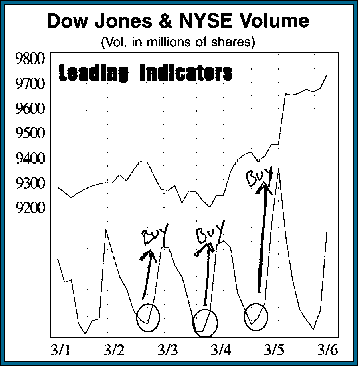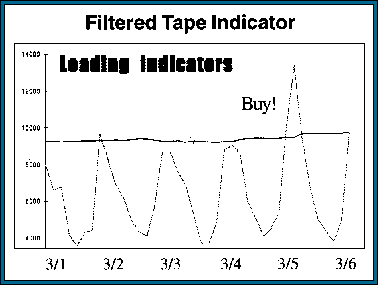A Split Market
Talk about a tough market to interpret! The stock operators (i.e., manipulators) on Wall Street have made the market analyst's job extremely difficult, and we have no way of knowing for certain whether this is a market in net distribution or net accumulation. One thing we do know—there is no way of unequivocally interpreting this market as it can be interpreted two ways. Stan Weinstein, editor of The Professional Tape Reader sums it up best in stating "We're dealing with a split tape, so it's time to become even more cautious. Furthermore, if the Dow closes below the key 9085, that will be an important intermediate term sell signal, and this difficult tape will become even more of a problem. In the meantime, stock and group selectivity remain very important."
Friday's all-time record-setting Dow performance, while impressive in percentage gain, was not so impressive in terms of trading volume. We have emphasized for weeks the importance of volume in this market and we consider it the single most important indicator for interpreting market action right now, even more so than the chart itself. We predicted last week a breakout from the Dow's two-month consolidation rectangle pattern and we indeed witnessed a breakout. However, we stipulated this breakout must occur on significantly increased volume in order to be valid, and while NYSE trading volume was increased, it was by no means a significant increase from recent weeks and did not quite correspond to the tremendous point gain. This gives us reason for concern. This is not to say volume was non-confirmatory. Only that we would have liked to have seen much greater volume in order to feel comfortably bullish.
We must now watch the volume very carefully this week to see what is really happening here. Two things can happen that will give us better insight as to what is happening in the market: the first couple of days this week may witness a slight correction in price accompanied by significantly lower volume, thus forming a bullish "flag" pattern. This will let us know the trend is most definitely up in the near term and the breakout was for real. The other constructive thing that can happen is to see the momentous bullish trend immediately continue with significantly increased volume over the next few days on the up days. This will also confirm a true bullish trend. If, however, we witness a failure where prices fall back below 9400 support (formerly resistance) or a gradual erosion of prices on high volume, we know the fix is in (for the near term at least) and lower prices are ahead. Again, this week will tell us much.
The chart showing the correlation between the Dow Jones Industrial index and NYSE trading volume shows three clear cut buy signals flashed over the last week. As indicated on our chart, these occurred when volume began rising while the market was falling—a technical divergence that normally signals a bullish accumulation underway. What this chart graphically demonstrates is action on the tape. The tape always tells the truth. And the tape showed as early as last week a few days before Friday's breakout that shares were being accumulated in anticipation of a breakout. However, this chart shows internal action only for the week of March 1 and must not be relied upon to give us a clear picture of the bigger market picture—only for the very near term. The bigger market picture, as we stated previously, is more ambiguous and we must wait before making any firm conclusions.

Our latest indicator—the Filtered Tape Indicator (a Leading Indicators invention)—shows an all-out buy signal that was flashed late last week. Traders acting on this signal could have anticipated Friday's breakout by at least a day. The basis for this indicator is to buy whenever the lower line penetrates above the upper horizontal line but only when the upper line is trending in an upward gradient (even though it may be only a slight gradient). Since it is based on the "tape," it is a very reliable indicator.

Many advisors are predicting nothing lower than a Dow 8650 if the market breaks below 9100 support. While 8600 is the next chart support level down, under the alternation principle the next likely target would be at or below 7000 if the market did indeed break below 9100. In other words, it's all or nothing to the downside if one argues the market's next move is a break below 9100 critical support—there can be no happy medium at 8650, because in reversing its uptrend the Dow would be compelled by weight of market forces to drive to considerably lower levels. Conversely, it's all or nothing to the upside if the market continues to move higher accompanied by good volume action, and we can expect a possible ultimate high of approximately 11,600 if the rule of alternation is a trusted guide.
Quite simply, this is the absolute best type of market condition we could hope for. Whether the market breaks to the upside or the downside we know it almost certainly will be a powerful break in either direction, meaning, of course, we can make tremendous profits if we are positioned to take advantage of the move.
Advisor sentiment is confused, plain and simple. There is an all-out bull and bear fight with roughly an equal spread between those who favor a bullish interpretation and those who expect the market to turn bearish. This is precisely the right type of environment for a major breakout to occur because it represents extreme tension in the market. This tension—produced by the strong tug-of-war between bears and bulls—has brought the Dow to an almost complete standstill. In the realm of physics, this would be known as forced inertia. The Dow has hitherto demonstrated a strong upward bias and outside forces are acting in concert to halt that upward momentum. The bulls, meanwhile, are attempting to rescue the Dow from failure and propel the market upward against the opposing strength of the bears. In short, due to the enormous counterbalancing forces exerting pressure on the Dow, the Dow must eventually respond in one of two ways: a massive blastoff to the upside or an equally pronounced crash to the downside. There is no in-between. Although we are more and more becoming convinced the next big move will be a move to new all-time highs, we cannot rule out a possible failure, and we must all be prepared to quickly respond to such a possibility.
From a chart pattern perspective, we note that the Dow's daily bar chart showed the formation of an ascending triangle, which prices broke out of on Friday. This pattern—usually (but not always) a bullish continuation pattern—is distinguished by a rising support (demand) line and a horizontal overhead resistance (supply) line. This pattern is a geometric representation of rising demand meeting a relatively steady supply—a bullish factor in most cases. Overall strength still favors the buyers over the sellers, at least for now. It is still possible that supply will overwhelm underlying demand, but for now, the buyers have the upper hand in that they have successively repelled every effort of sellers at driving the market lower.
The Dow Jones Transports, meanwhile, are heading toward 3500 once the present consolidation is completed. Remember, though, that 3400 resistance is an extremely crucial one from a Fibonacci and chart perspective. It must be overcome in order for the bull trend to be confirmed. Utilities, meanwhile, continue in a technical downtrend but are presently undergoing a reaction near the $295 minor resistance zone. This could be nothing more than a correction in a larger bear pattern but we won't know for sure until $290 support is firmly broken. A move above $315 intermediate resistance is needed to turn the trend technically up again.
Most instructively, the chart showing NYSE advancing and declining volume does not support a bearish outlook in the immediate term. This is not to say the bull market is firmly intact, for surely we are witnessing the deterioration of the long-term bull trend. But in the very near future, higher prices are still possible based on volume action. Specifically, NYSE advancing volume is fairly steady while NYSE declining volume has been declining. For a near term bear market signal we would need to see steadily increasing downside volume and decreasing advancing volume, but this so far has not been the case. Still, it cannot be denied that market breadth and volume action have deteriorated markedly over the past several months and this is not a good sign for the long term health of the market.
The bull is clearly in its death throes, but don't count it out until it actually dies. We will continue to let the market itself be our guide and not jump to untimely conclusions based on technical indicators, which tend to send out misleading signals at the end of every major bull market.


















